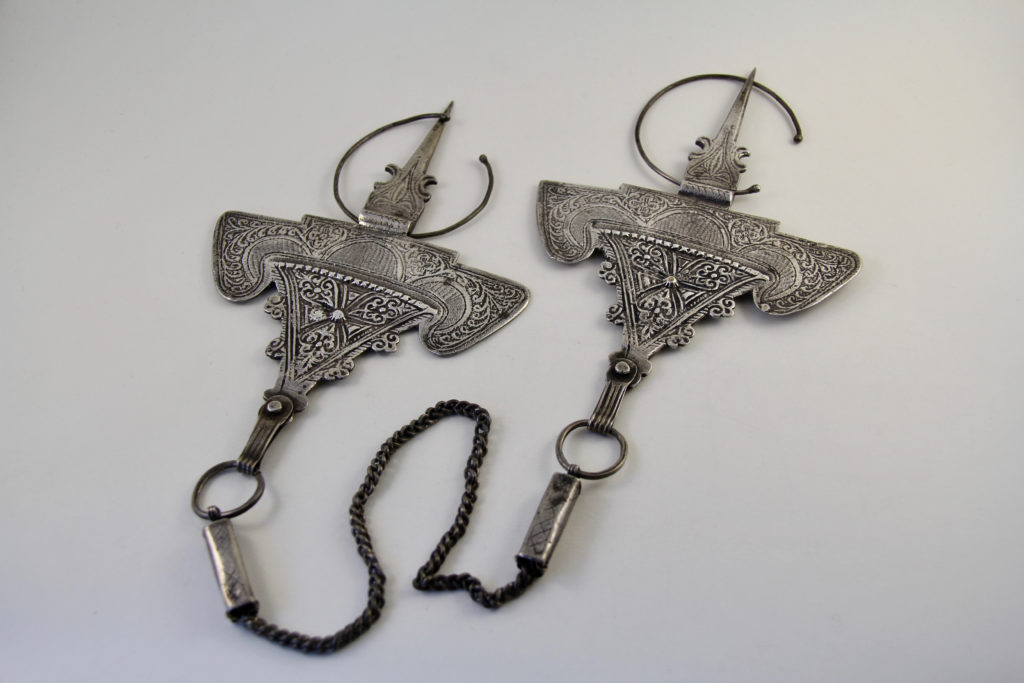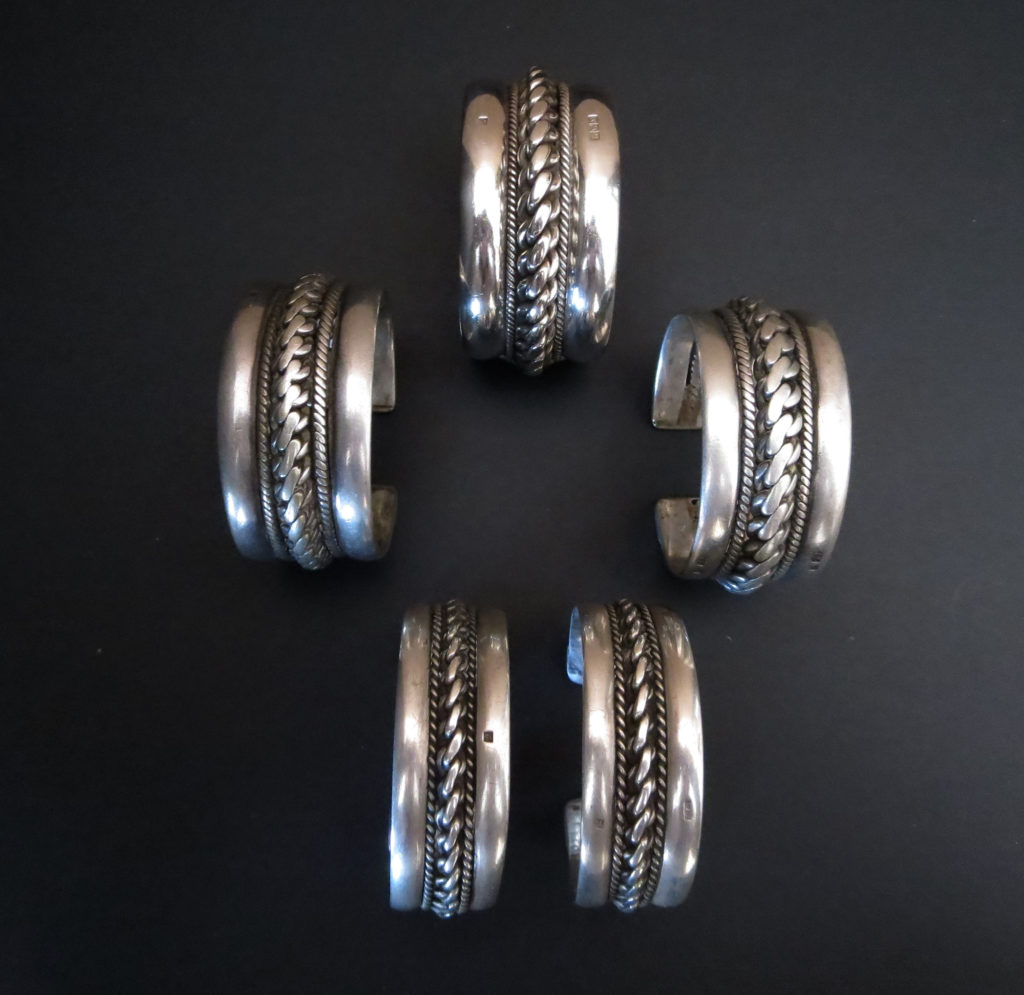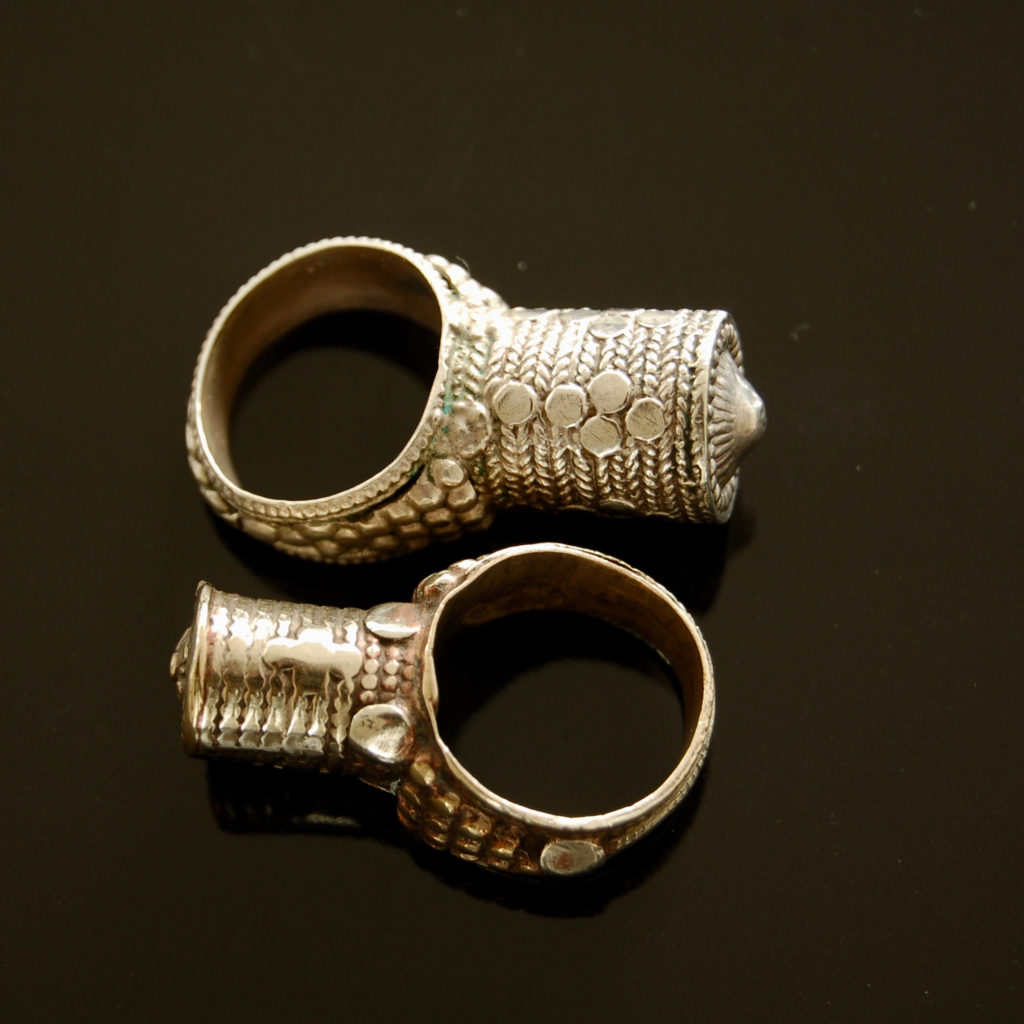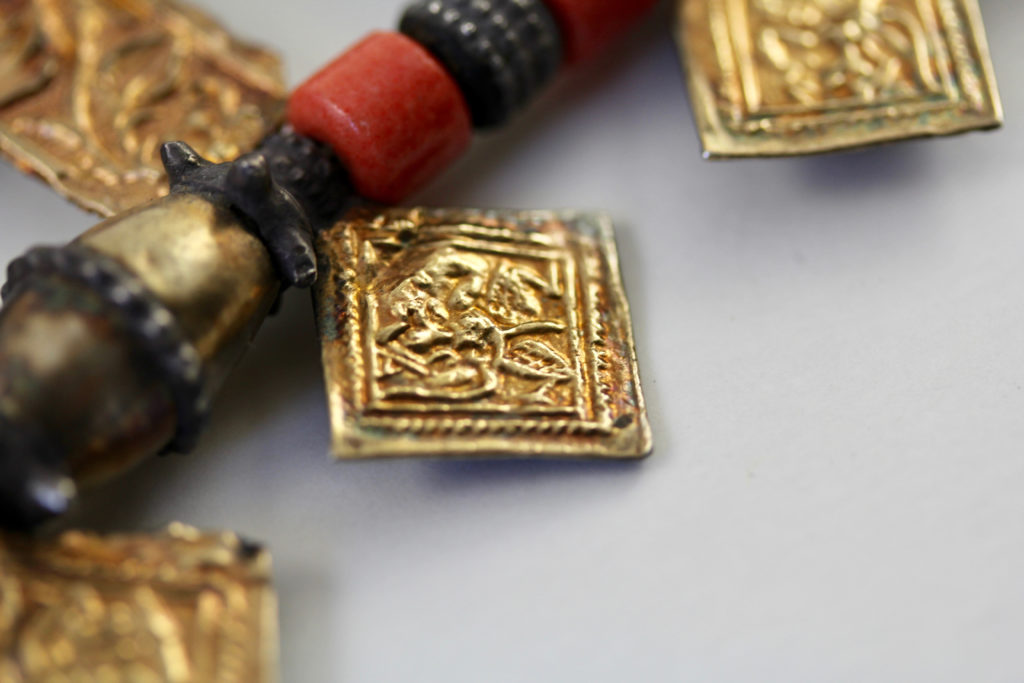Jewellery in the Arab world is like a language. It tells you many things about the wearer, stories that unfold if you know how to read them. In this blog post, we will look at jewellery, identity and cultural contacts.
 A pair of fibulas from Morocco
A pair of fibulas from Morocco
This is a pair of silver clothing pins or fibulas. These were used to fasten clothing: a single piece of fabric was wrapped around as an outer layer and fastened at the shoulders with these beautiful pins. This way of wearing and fastening clothing was only used in the Maghreb, so the first thing we learn when we see a woman wearing these, is that she is from Morocco, Algeria, Tunisia or Libya. Within this region, there are many distinct types of fibulas. These tell us more precisely where she is from, as every area, tribe and sometimes even town has its own style. This pair has stylized rams’ heads as its basic shape, and it is beautifully decorated with floral forms: these fibulas were once worn by a woman from one of the HaHa-tribes at the Atlantic coast of Morocco, between Essaouira and Agadir.
 Made in Cairo, worn in in Palestine
Made in Cairo, worn in in Palestine
These bracelets are called
asawir melvi, or ‘plaited bracelets’. You can see where they get their name from: their main characteristic is the twisted band in the middle. These were worn in pairs by women in Cairo and the Nile Delta, but also by the Bedouin of Sinai and southern Palestine. When we see a woman wearing these, her costume and specifically her type of face veil will tell us if she is from Cairo, Sinai or southern Palestine. The bracelets have all been made in Cairo and were sold to the Bedouin by travelling merchants. This not only tells us where the wearer is from but also how far her cultural contacts extended.
 Close neighbours
Close neighbours
These two rings are very characteristic of two countries that have been close neighbours for centuries: Yemen and Ethiopia. Although they are separated by water, they are close enough to have traded since Antiquity. This cultural proximity is visible in jewellery as well. Rings like these are worn on both sides of the sea, in both the coastal areas of Yemen and Ethiopia. It is very difficult, if not impossible, to discern from which country each ring is. An excellent example of how jewellery and dress together form a unique combination that tells us about shared heritage and cultural contacts!
 Where can I read more?
Where can I read more?
There are many books about jewellery. A few suggestions to enjoy about jewellery and identity are:
- Silver Treasures from the Land of Sheba, by Marjorie Ransom: a beautiful book detailing regional Yemeni styles of jewellery. Published by AUC Press, Cairo
- Enchanted Jewelry of Egypt: the traditional art and craft, by Azza Fahmy: a beautiful book, detailing regional Egyptian styles of jewellery. Published by AUC Press, Cairo
- Bijoux du Maroc, by Marie-José Rabaté: two well-illustrated volumes dedicated to the jewellery from Morocco. Published by Edisud





 A pair of fibulas from Morocco
This is a pair of silver clothing pins or fibulas. These were used to fasten clothing: a single piece of fabric was wrapped around as an outer layer and fastened at the shoulders with these beautiful pins. This way of wearing and fastening clothing was only used in the Maghreb, so the first thing we learn when we see a woman wearing these, is that she is from Morocco, Algeria, Tunisia or Libya. Within this region, there are many distinct types of fibulas. These tell us more precisely where she is from, as every area, tribe and sometimes even town has its own style. This pair has stylized rams’ heads as its basic shape, and it is beautifully decorated with floral forms: these fibulas were once worn by a woman from one of the HaHa-tribes at the Atlantic coast of Morocco, between Essaouira and Agadir.
A pair of fibulas from Morocco
This is a pair of silver clothing pins or fibulas. These were used to fasten clothing: a single piece of fabric was wrapped around as an outer layer and fastened at the shoulders with these beautiful pins. This way of wearing and fastening clothing was only used in the Maghreb, so the first thing we learn when we see a woman wearing these, is that she is from Morocco, Algeria, Tunisia or Libya. Within this region, there are many distinct types of fibulas. These tell us more precisely where she is from, as every area, tribe and sometimes even town has its own style. This pair has stylized rams’ heads as its basic shape, and it is beautifully decorated with floral forms: these fibulas were once worn by a woman from one of the HaHa-tribes at the Atlantic coast of Morocco, between Essaouira and Agadir.
 Made in Cairo, worn in in Palestine
These bracelets are called asawir melvi, or ‘plaited bracelets’. You can see where they get their name from: their main characteristic is the twisted band in the middle. These were worn in pairs by women in Cairo and the Nile Delta, but also by the Bedouin of Sinai and southern Palestine. When we see a woman wearing these, her costume and specifically her type of face veil will tell us if she is from Cairo, Sinai or southern Palestine. The bracelets have all been made in Cairo and were sold to the Bedouin by travelling merchants. This not only tells us where the wearer is from but also how far her cultural contacts extended.
Made in Cairo, worn in in Palestine
These bracelets are called asawir melvi, or ‘plaited bracelets’. You can see where they get their name from: their main characteristic is the twisted band in the middle. These were worn in pairs by women in Cairo and the Nile Delta, but also by the Bedouin of Sinai and southern Palestine. When we see a woman wearing these, her costume and specifically her type of face veil will tell us if she is from Cairo, Sinai or southern Palestine. The bracelets have all been made in Cairo and were sold to the Bedouin by travelling merchants. This not only tells us where the wearer is from but also how far her cultural contacts extended.
 Close neighbours
These two rings are very characteristic of two countries that have been close neighbours for centuries: Yemen and Ethiopia. Although they are separated by water, they are close enough to have traded since Antiquity. This cultural proximity is visible in jewellery as well. Rings like these are worn on both sides of the sea, in both the coastal areas of Yemen and Ethiopia. It is very difficult, if not impossible, to discern from which country each ring is. An excellent example of how jewellery and dress together form a unique combination that tells us about shared heritage and cultural contacts!
Close neighbours
These two rings are very characteristic of two countries that have been close neighbours for centuries: Yemen and Ethiopia. Although they are separated by water, they are close enough to have traded since Antiquity. This cultural proximity is visible in jewellery as well. Rings like these are worn on both sides of the sea, in both the coastal areas of Yemen and Ethiopia. It is very difficult, if not impossible, to discern from which country each ring is. An excellent example of how jewellery and dress together form a unique combination that tells us about shared heritage and cultural contacts!
 Where can I read more?
There are many books about jewellery. A few suggestions to enjoy about jewellery and identity are:
Where can I read more?
There are many books about jewellery. A few suggestions to enjoy about jewellery and identity are: